Since the beginning of our trip, we have been very surprised to hear, everywhere in Europe, teachers, education specialists or parents involved in schools, tell us that the Finnish educational model was not so extraordinary only that. We are given, as proof, statistics on the homogeneity of the population, we are told of the fact that the country is multiplying the reforms (one will come very soon) or examples of teachers having left Finland to teach elsewhere because they did not believe in their system. We will come back to this in a future article where we will try to decide together, the true from the false because, you will admit, for us who constantly refer to it, it is destabilizing to hear these comments. But, whether we consider the Finnish educational program to be the best in the world or not, we have to admit that it remains THE world REFERENCE in terms of education and we were lucky to spend a day, very far of daily life in North American schools, at the Kaisaniemi school in Helsinki. Story of a day in a Finnish school, October 31, 2019!
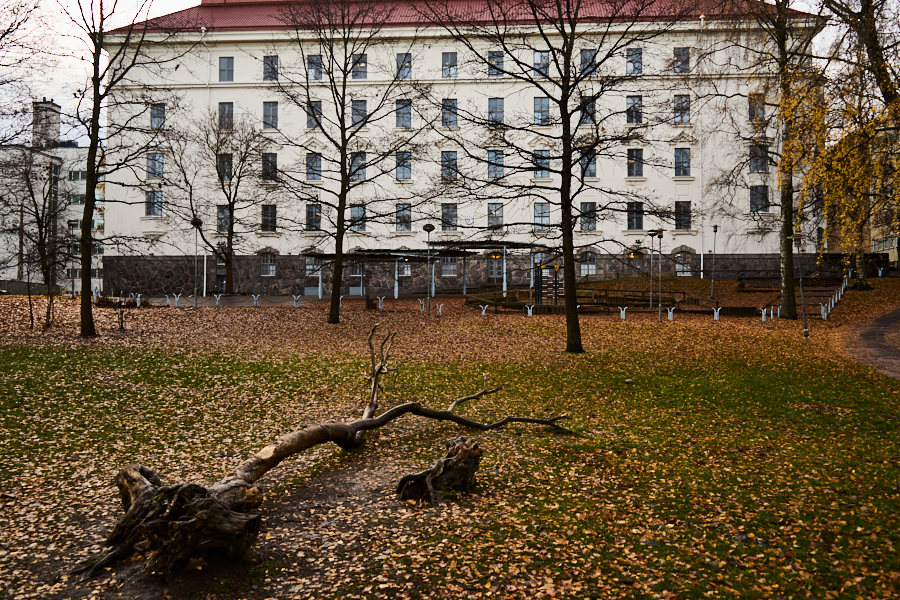
Schedule and program
The hours here are never fixed. Each child having his own. In connection with the options he has chosen or not, his strengths and weaknesses, he will arrive at school between 9h and 1oh and will finish his day between 1:15 and 15h (16h, some days, for concentrations). Some students, very involved or with a greater desire to learn than others may have slightly busier schedules, but, as far as possible, we try to avoid the child spending more than 5 hours , per day, in progress. Although certain subjects are compulsory, such as Finnish, a foreign language (the choice is very large), sport, mathematics, science and manual work, others are at the discretion of the student, interests and level of comfort. For example, a child who already has difficulties in school will not be obliged to take a third language, even if it is favored in Finland. And if he does not like the arts, he will not have to enroll in drama or art history courses in addition to the compulsory handicrafts course. From the outset, we judge that the child is able to make his decisions and we leave him free to follow his passions while making sure to give him the basic general knowledge that will allow him to discover them in the compulsory subjects.
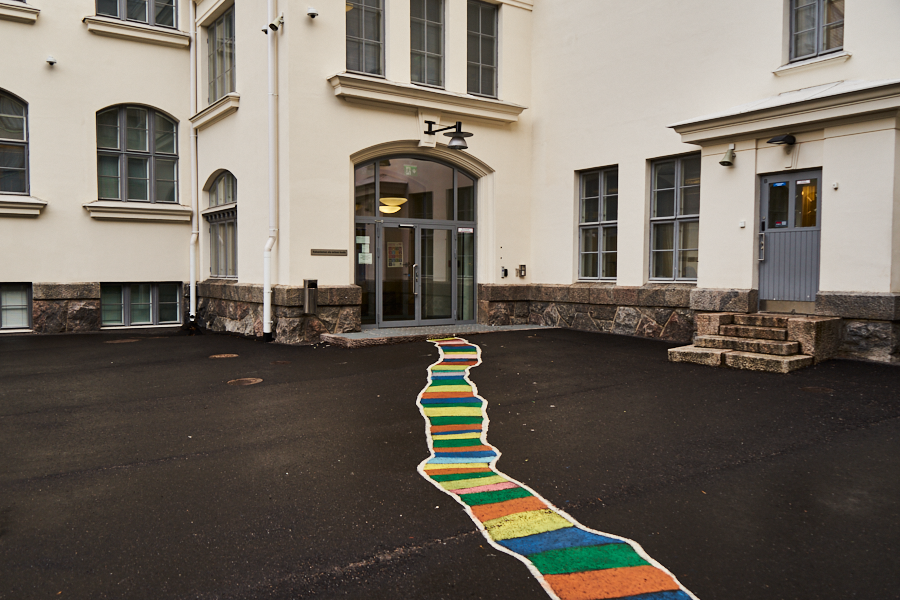
The Kaisaniemi school welcomes children from 7 to 12 years old (1st to 6th grade). In Finland, school starts at age 7, not before. There are obviously crèches or nursery schools and childcare services for children whose parents work, but academic learning properly speaking will not begin until this age. Although it is a neighborhood school, so about half of the children who attend it live in the residential areas surrounding Kluuvi, the business district in the heart of Helsinki, the other half of the children live almost everywhere in town and even in the suburbs since the school offers a specialization program in dance and music. Students doing this program are selected based on their excellence in this area and will be offered additional lessons in their schedule to perfect their art. All the children of the school have music lessons, since they are part of the national curriculum, and occasionally they also dance in the sports course, but they will only have access to the specialization courses they passed the entrance exam. They can, on the other hand, choose to register for an advanced arts course (visit to museums, art history, practice, etc.) or a drama course, in addition to their program regular. For pupils with difficulties, individual help or additional courses in the basic subjects can be offered. These lessons will then take place between 9 a.m. and 10 a.m. and between 1.15 p.m. and 3.15 p.m. in the afternoon. The vast majority of children have at least one or two lessons a week during these periods. But, if you do the math, you will understand, a standard school day in Finland lasts between 3 hours and 7 hours although the days rarely exceed 5 hours as said before.

A free and healthy canteen
In Finland, as in many European countries, lunch is served in the school canteen during the 30-minute break children are entitled to. The groups, accompanied by their teacher, will have dinner, one after the other. Here, every day, the children have the choice between a vegetarian dish or a meal with meat and several side dishes. Food is at will and the children serve themselves, since it is judged that it is up to them to make their choice as to what they eat and in what quantity. Either way, only healthy food is served, and, note, in Finland, it’s free for everyone. Saana Kaitaranta, the school’s vice-president, is number one reason for the country’s educational success. First, regardless of their social status, children eat their fill (a snack is also offered in the afternoon for those who have lessons after 1:15 pm or who attend the equivalent of their daycare). Then, and that’s what she believes is the key, kids eat healthy, and only house food. They are therefore protected, during school hours, from processed industrial products filled with food additives, preservatives and sugar. According to her, the attention of children is therefore greatly improved and their concentration remains sustained throughout the day.


Our day at Kaisaniemi school
Our day begins at 10:15 am in the class of the vice-president whom we will accompany for the morning. Here, the children are 10 years old and are in 4th grade. And we are not the only observers today. The big sister of one of the girls who goes to school is here. Graduating at the BAC (in Finland it is a period of 2 years after high school which is therefore somewhat the equivalent of our CEGEP), she plans to continue her studies in teaching at the University. But here is a very long, difficult and limited program. Teachers have the same social status as doctors or lawyers, but there is a long way to go. Mastery is compulsory for all levels as well as specializations. So she volunteers at this school as often as possible. It allows her to make sure that this is what she really wants to do and to gain experience, which will be good for her application.
After having introduced ourselves and given the corrections to the previous day’s work to the children, we take the direction of the other 4th grade class. Here, the teachers work regularly as a team. Some children can go to spend the day in the other class (for example, if they need to review a subject, lack of time for an arts project or to lend a hand), projects are made together , and if one of the teachers is absent for a meeting or a meeting with a parent, the other will take over and take care of the two groups. In several schools in Finland, a wall between the two classes can be opened to facilitate this work. Here, this is not the case. Children therefore move around in one class or the other. Like many of our schools in Quebec, they are overcrowded. The classes, which according to the teachers are suitable for groups of 20 and 24 pupils, often have up to 32, except in manual work where the classes are divided in half for a maximum group of 17 even if, for the teachers , a maximum of 10 students in these classes should be privileged to really meet the needs of children. A teacher will deplore this fact by telling us that it is no longer possible for them to focus on the real needs of children. He teaches point material. The teachers we spoke to also lamented the lack of funding for support staff. A third-year teacher who has a group of 32 students this year, including three with special needs, only helps her class for 2 hours a week. Like what, even in this model country in terms of education, the problems do not differ from ours. In this school opened in 1924, the premises are also very small, more than in the new schools. We are therefore trying to find solutions to overcome the difficulties that this situation causes. For example, children who want to can wear earmuffs while working to help them focus. Although the classes are very small, it is normal to see children walking around the classroom and even outside it during lessons. As long as the objectives are achieved, this is not a problem since it is obvious to the staff, that a child is not made to sit all day. And since children are not always in school, some are free or on a meal break while others are in class. There is therefore constantly noise and movement which represents a challenge for some children.

Dance in sports: an unusual event
Today, December 4, takes place in Finland a very prestigious and expected traditional event. 4th grade children, accompanied by their parents, will be received by the mayor of their city and his wife. Long dresses, toxedo and traditional dances will be in the spotlight and it is important for them to prepare for it. Fall sports classes, including the one we attended, therefore focus on dance to allow children to be ready for this very important event for them. In the classroom, they will practice, using a YouTube video, the practice of dance (this time non-traditional) which they will present to the mayor. They chose Happy and the choreography is very energetic. After this practice, we go to the gymnasium, where the space is larger, for the rest of things. Here, the children will practice the real traditional Finnish dances, couple dances, which the children will have to do during the evening. They have 5 to learn and it’s serious. Everything has to be perfect, it goes to the honor of the school. Among the fifty children present, 22 girls and 2 boys are part of the school’s dance concentration. For them it’s clearly easier and they get bored quickly. For others, it is hard work and it is clear that some people do not enjoy it, but it is an important rite of passage in Finland. They will have spent more than 2 hours there each week until today and even more during the past two weeks. For teachers, it is a very stressful event for which they feel a lot of pressure. Everything MUST be perfect, so is their reputation.
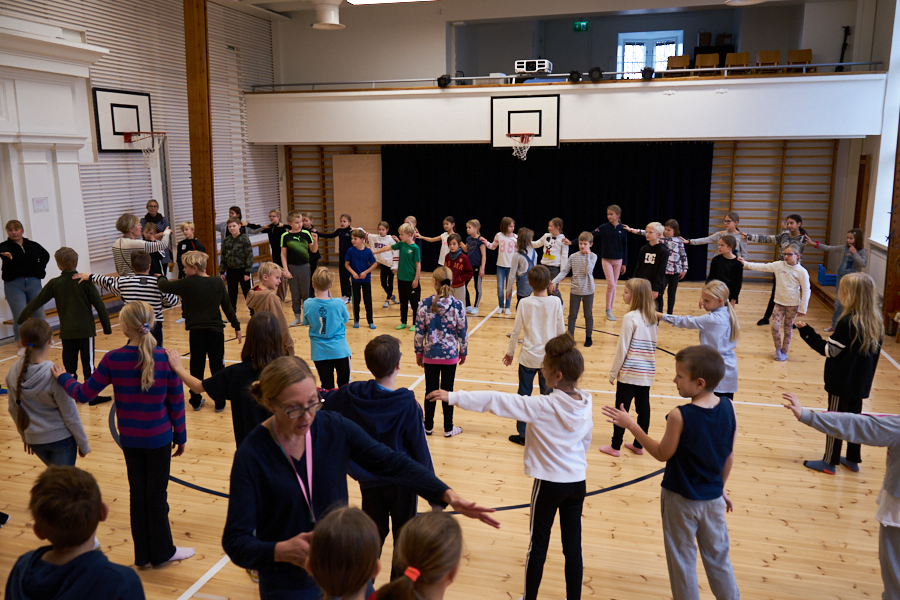
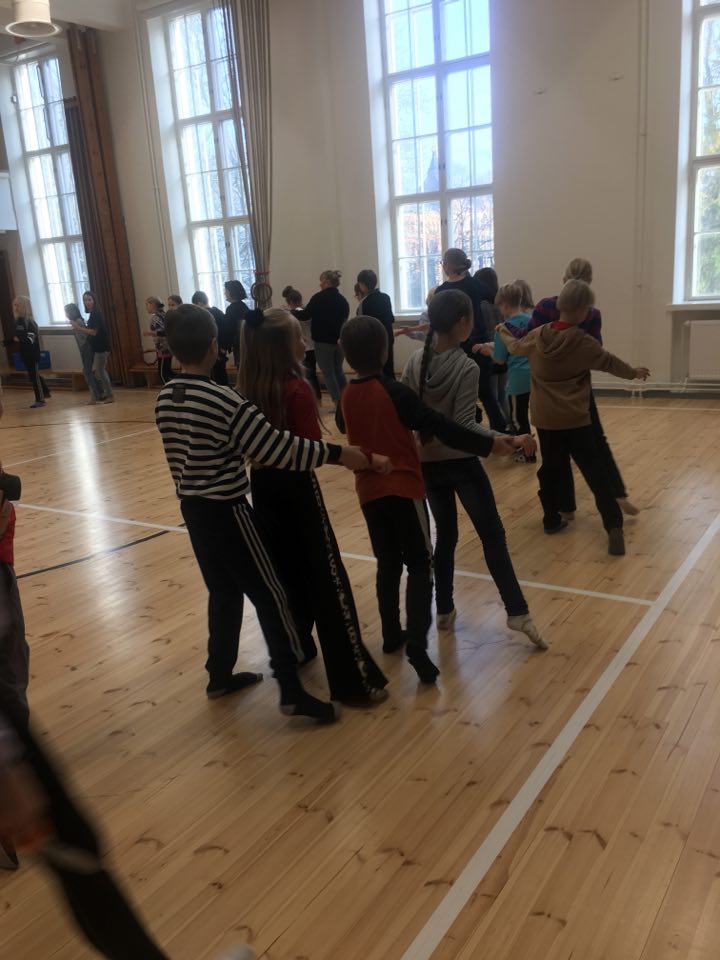
Manual work class
After dinner, we join the grade 3 music concentration class, which has a craft class this afternoon. Since they are concentrating on music, they only have one hour per week of manual work while the other students of the school have two hours. A typical week for an average child is defined as follows: 4 hours of math, 5 to 6 hours of mother tongue, 2 hours of science, 2 hours of sports, 1 or 2 hour (s) of manual work, 2 hours of music and 2 hours for each of the optional courses they take. To this is added, around the 3rd year, a second language of the student’s choice between French and English, and for many, a third language (at the child’s choice between French, English, German and Swedish). Each of these courses represents 2 additional hours.
But back to the class of manual work, one of the very envied features, of the educational program of Finland. Here the group will be split in half. Part of the class will work in the textile arts while the other part will go to the carpentry room. Their project finished, they will change premises. The children’s timetables are constructed so that while one of the two groups at one level has a second language course given by a specialist, the other group is doing manual work, which allows the two teachers at the level to share the manual work group. At the moment, in the textile arts class, the 3rd years learn to use a sewing machine and also do printing on fabrics. Their current project is therefore to manufacture from a to z, a tote bag type. To do this, they must draw the pattern and reproduce it on the fabric, cut it, thread it and use the sewing machine to assemble their bag, determine the patterns they want to make on their bag on a plan, learn the techniques of ‘impression on fabrics then realize their model. Once their project is finished, they will go to the school’s Google to give an account of their project, with a photo of it. Everything will then appear in the child’s portfolio. But the textile arts don’t stop with machine sewing. Over the years, children will learn knitting, crochet, embroidery, hand sewing, etc.
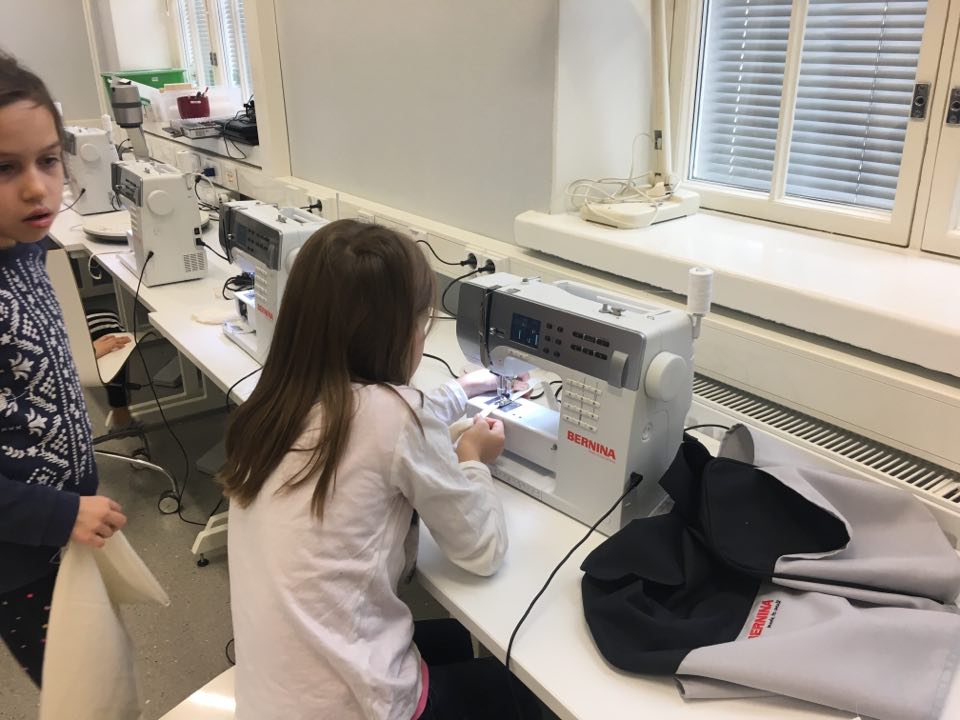
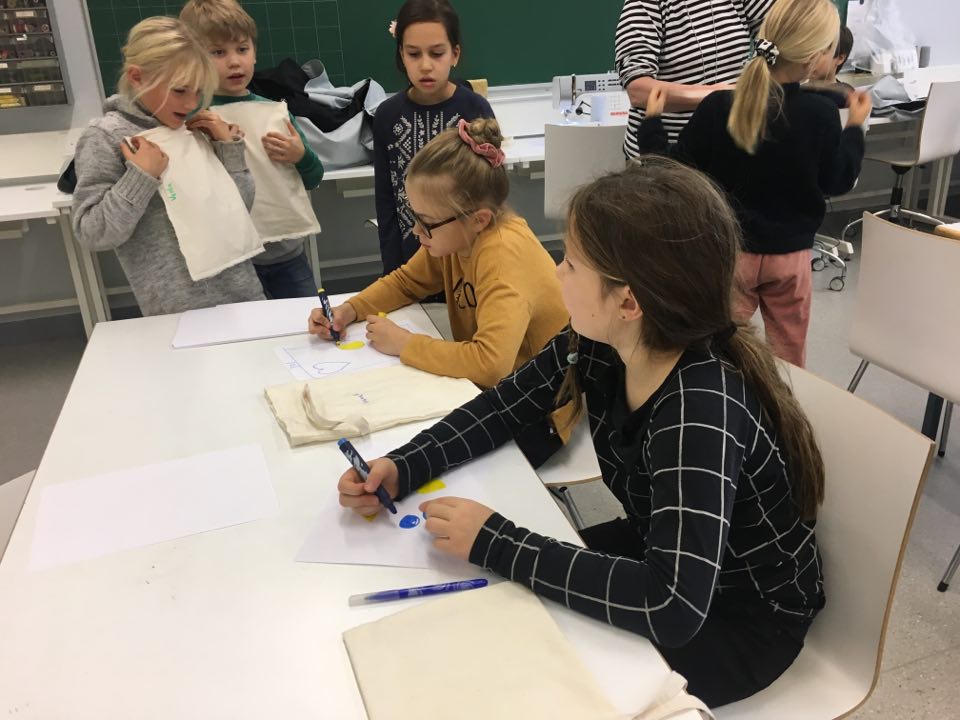
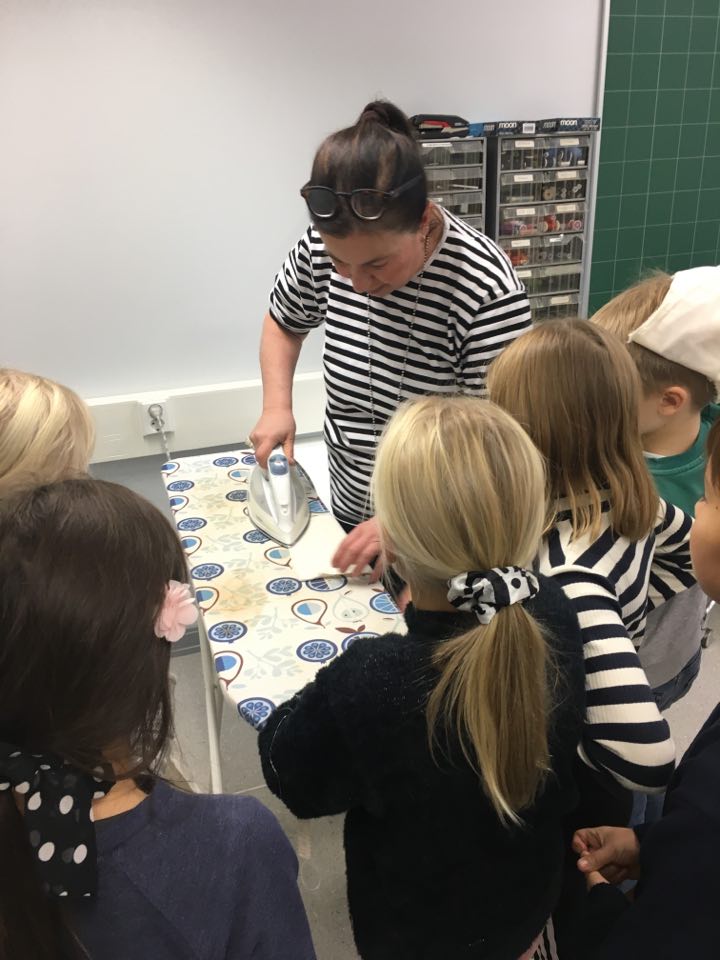
At the same time, in the carpentry workshop next door, the other part of the group plans to build a wooden toy of their choice out of wood. The image has enough to give cold sweats to many people used to seeing children handling such tools! Here, 9-year-old children freely use a scroll saw, hammer, wood chisels, sandpaper, screwdriver and chisel surrounded by machines such as a table saw, band saw, wood lathe, etc. They will learn to use later in their journey. A little girl is precisely sawing the pieces of the puzzle she is making. Others make a car or a board game under the watchful eye of their teacher. Another child uses a wood chisel to engrave patterns on one of his pieces and a small group is in the back room, busy painting certain pieces that will bring color to their project. All the tools are within reach in a large cabinet and they will get what they need when they need it without having to ask for permission. Sometimes the teacher will correct a posture or a movement, explain a little more the use of such or such tool, but on the whole, the children will work in a completely autonomous and safe way.
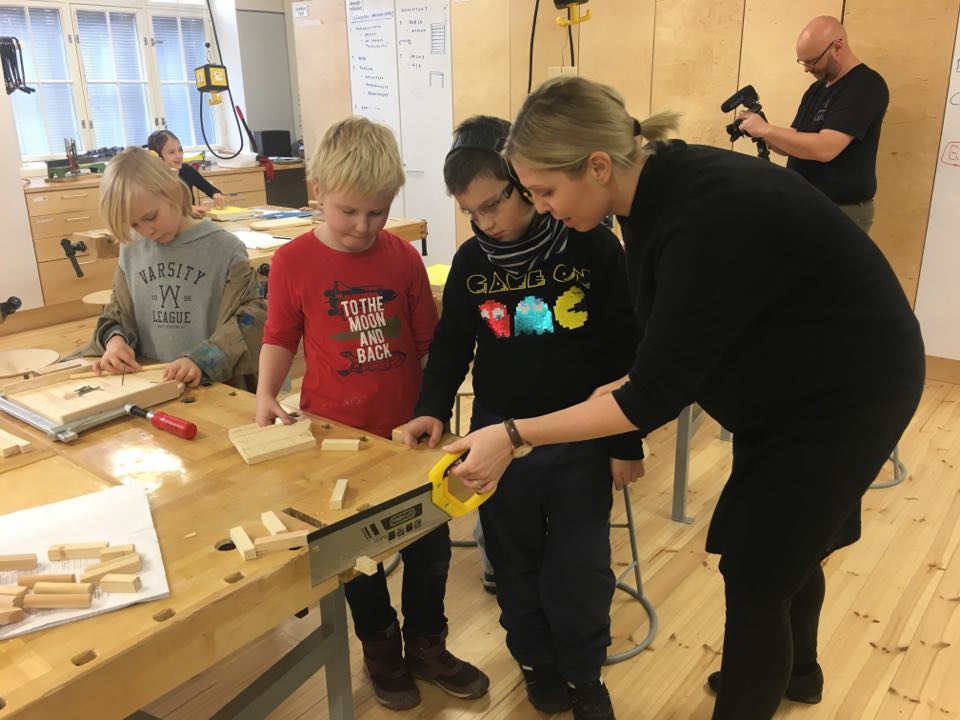
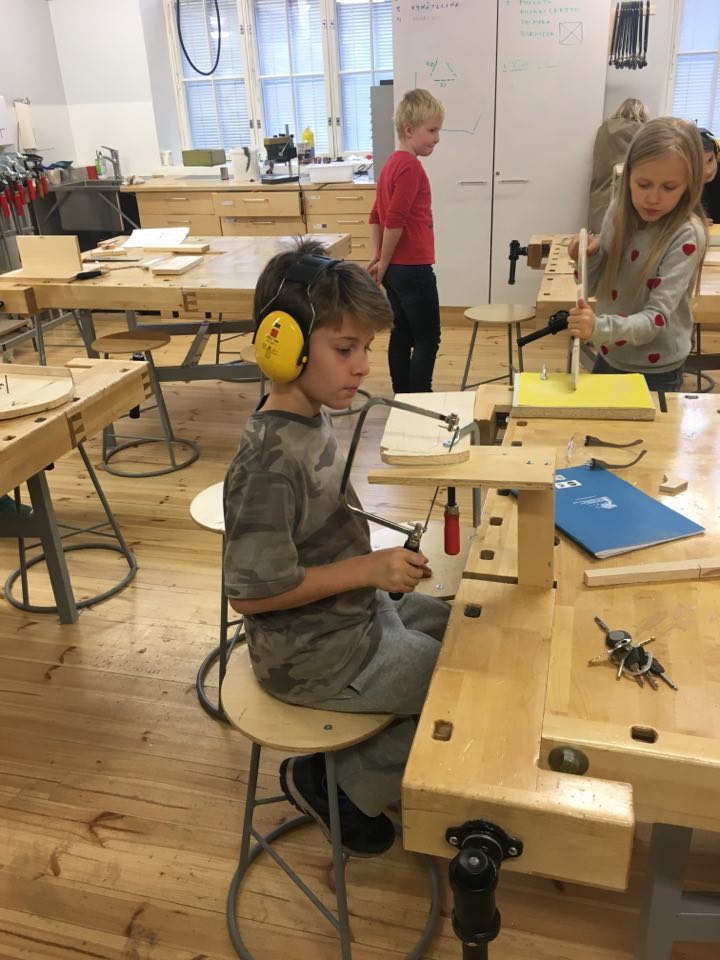
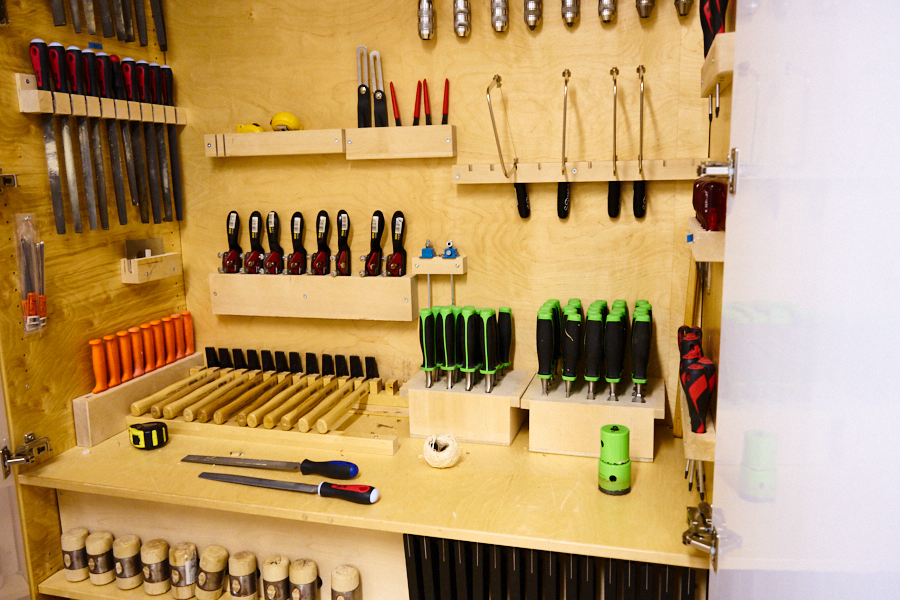
Conclusion
When the school told us about the observation program they offered us, we were surprised that none of the courses that we consider the most important in Quebec, such as languages or mathematics, are not included. It was quickly explained to us that it was precisely because, in Finland, no subject was considered more important than another that this choice was offered to us. Of course, we consider it important to know how to read or write or to know how to count, but for them, children will learn well what is necessary for the full development of their personality and their career plans at the right time. While waiting for this choice to emerge, it is necessary to sow seeds and allow children to freely explore as much material as possible to help them discover themselves. So that’s, for me, all the magic of school in Finland!